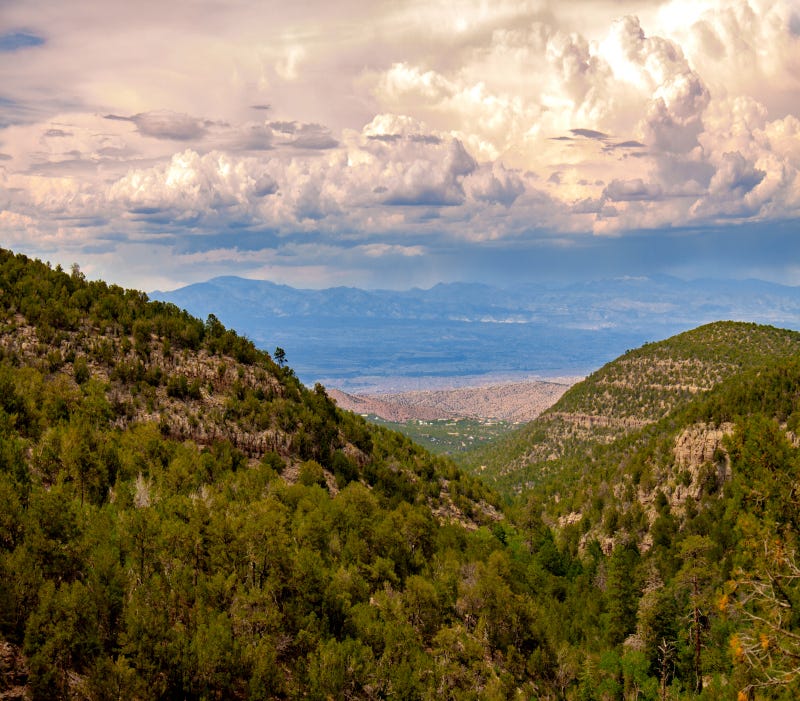
High on the side of a rock wall in the Sandia Mountains, at the end of a difficult trail, there is a cave where people lived 10,000 - 14,000 years ago. This was the age of the mammoth, mastodon, sloth, rhino, horses, and camels in North America, and the high cave opening on the rock wall served as protection. Today, even with the spiral staircase it is unsettling to be hanging high in the air with feet dangling. I brought water and a flashlight, and crawled on my stomach deep down through ten inch openings, with thick fine dust covering the floor. Eventually there was a larger opening, expanding into a “room” for several people to sit in. Only the most dedicated have made it this far. In the dark and silent room I slowly came to sense a presence with the people who lived there long ago – this had been their home for centuries, much longer than any human settlement in modern civilization, the home of children and adults living their lives.
The flashlight revealed the cave was full of ochre, the oldest natural pigment in the world. Anyone who has studied art will know that ocher is one of the fundamental colors on the historical palette, being a mixture of clay, iron oxide and sand. Unfortunately, any artwork that might have been in the cave had dissipated, but one thing known about cave art globally at this time – children between the ages of 2 and 7 were heavily involved, and their art was all over the place! Cave art generally shows meandering lines, arrow points, animals, and hut-like figures, which are thought to have held symbolic meaning for hunter-gather groups 13,000 years ago. In the Sandia Cave, stone arrow and lance points, basket scraps, bits of woven yucca moccasins, and skeletal remains of Ice Age animals have been found, all good sources of inspiration for art.
At some point early in life, children would emerge to view the larger world beyond the cave. This was the point in life where projections on the dark cave walls would be expanded and children would see the astonishing enormity, the endless vista of the wider world, a time when old mental constructions would be replaced with new understandings, new actions integrated, altering fundamental meanings in life. This essential transition from a limited cave world view to an explosive and newly creative vision of reality is fundamental to the way we humans grow and change, synthesizing our old limited perspectives with the new.
Even in the fourth century BCE, Plato understood this emergence, with his Allegory of the Cave. In Plato’s Cave, prisoners are held captive from birth, and only see shadows and figures on the wall. Like the children in the Sandia Cave, their entire world view is based on what they see on the wall. At some point, one of the prisoners escapes and runs out of the cave, suddenly experiencing the amazing colors and shapes. This results in an earth shattering transformation, a new mindset, a paradigm shift that is far beyond the world view of the cave wall. The freed prisoner has become aware of reality, and realizes that the previous view is inadequate. To survive with the new influx of information, the prisoner must construct a mental framework that transforms the cave - framing it within the new expanded reality. We all go through such transformations daily in small and large ways, we “change our mind” when new information contradicts our previous assumptions. We preserve our sense of self worth, our sense of place in the transient world, and we open ourselves to new possibilities.
There are people all around the world who love to crawl deep inside caves. I can’t help but believe these Spelunkers have discovered something the rest of us might learn from. After being in a cave for several hours and then emerging into the brighter wider world, there is an enhanced and intensified opportunity to see reality with a beginners mind, unclouded by distractions and delusional distortions, beyond the societal haze of everyday life. Of course, the cave is not “out there” somewhere - it is in our mind. When we are quiet enough to observe the display our mind continually creates, we are able to stand apart from it and place it in a larger context. The world appears anew, changed and focused - it is the simplicity of life seen as astonishingly beautiful. This is the creative beauty that is so severely needed in the times of disarray in which we now live.







i enjoy reading this robert. thank you for being an inspiration.
I really enjoyed reading this, Robert. I am working on my next article and although not the same topic, there is an underlying truth they both share. It must be something in the air :-) Your writing style is makes learning fun. I am looking forward to reading it again.